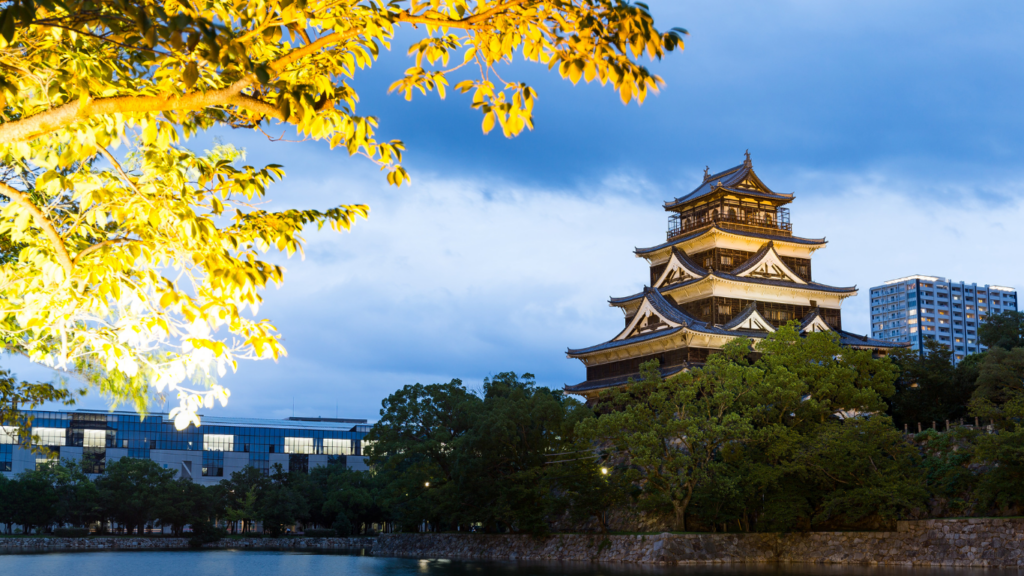Welcome to Hiroshima, Japan. Located on Honshu Island, most of us in the West think of the end of the Second World War when we hear the name of this city. Images of the atomic bomb dropped by the US to signify the end of the war in the Pacific come to mind, where an entire city was reduced to rubble in under a second. Over 75 years later, the city is a thriving metropolis. We decided to go on an adventure to learn more about this fascinating place, exploring Japanese history from the Asuka period right through to the horrific events of the 20th Century.

Rural Hiroshima
We landed at Hiroshima airport in the middle of the night, where over 13 hours ago we left the UK, it’s now nearly a full day ahead thanks to the 8-hour time difference. The second we step off the plane, we are bombarded by the relentless Japanese summer humidity. My eyes swelter as we make our way through immigration and onto the bus which will transport us to a traditional tatami room for our first night.
We wake up to the sound of a busy Japanese town outside. The first few nights we are spent in the small town of Ōasa, which lies about an hour north of Hiroshima in the Japanese countryside. Surrounding us we can see rice fields, mountains, and an awakening town. It’s a peaceful yet somehow busy atmosphere, with locals running around their daily lives as the town comes to life. We’re staying with a local, Hiro, who gives us a tour of the local area, including visiting a beautiful Japanese temple, where we pray and learn about Shinto. The local shinshoku, who happens to be a family friend of Hiro’s, invites us to a barbeque with his family that evening, where we dine on typical BBQ food (burgers and sausages), but also some more unique items. Cow’s tongue anyone? Apart from the cow’s tongue (which felt like I was chewing through a piece of rubber), it’s all delicious – we love the unique blend of Japanese cuisine mixed with the typical barbeque flavours.

After the BBQ and learning about local life from the other guests (my Japanese GCSE coming into play, although Hiro has to do most of the translation including fixing my mistakes), someone goes inside and brings out a watermelon, a blindfold, and a stick. ‘What on earth is going on here?’ I mutter to myself, before the next thing we know, we’re playing a game of ‘hit the watermelon while blindfolded’. Everyone takes it in turns to have a go at destroying the watermelon with the stick, kind of like a pinata. Not to brag, but I got it first try.

That evening, we dine on smashed watermelon while watching the fireflies forming around a nearby stream. It’s the first time I’ve ever seen fireflies, and it has to be one of the most beautiful things I’ve witnessed – thousands of tiny luminescent blobs floating and dancing above us. Hiro catches one so we can take a closer look. I still struggle to believe these little insects actually exist.

Hiroshima City
A few days later, after enjoying some more peaceful Japanese country living (including eating some incredible food), we say goodbye to our host Hiro and board a coach to our main destination – the sprawling urban mass that is Hiroshima. It’s not at the top of everyone’s must-visit when they come to Japan, but there are still some incredible places to visit, including the atom bomb museum, the island of Itsukushima with its incredible temple, and Hiroshima castle. At this point, we’re also keen to eat some Okonomiyaki, a savoury pancake dish that is a delicacy in this part of Japan.
After an hour in the (thankfully air-conditioned) coach, taking in the mountainous scenery (it’s seriously impressive), where small Japanese towns and villages are crammed wherever there’s space to build, we arrive in Hiroshima. It’s hot, it’s busy, but we’re immediately in love. It’s impossible to believe that all of this has been rebuilt in the past 75 years.

We catch a ferry to Itsukushima (also known as Miyajima), an island known for its beautiful shrine and floating torii gate. What seems to be lesser mentioned is the island’s deer residents, who are the opposite of every deer you’ve ever seen. The second we step off the boat, we’re swarmed by ten or so deer, attacking us tourists for our food and attention. It’s incredible to be able to stroke a deer but being attacked by one is just too surreal. I remember getting out a sandwich I’d bought from Family Mart (which all have their crusts cut off!) and being followed back onto the ferry by five or six deer all wanting a bite. It’s a hilarious and mildly terrifying experience.

As for the shrine on the island – wow. Seemingly floating on the water, Itsukushima Shrine is a peaceful Shinto holy site that, while popular among tourists, still manages to retain that Japanese sense of tranquillity. We watch a performance under the shade of the shrine and proceed to explore this little slice of traditional Japanese culture. It’s a crazy contrast to the city centre of Hiroshima, with its skyscrapers and busy streets. This is a step back in time – we love it here.

During the trip, we spent some time exploring Hiroshima Castle, which captures nicely how Japan, and most notably Hiroshima, rebuilt following The Second World War, where the castle today was rebuilt after being destroyed by the atomic bomb in 1945. The modern structure is built using traditional building materials and practices, where inside we explore the museum which covers the history of Japanese castles and Hiroshima. From the top, we take a look over the skyline, which gives you a great sense of scale for how this city has rebuilt itself.
We also visited the Hiroshima Peace Memorial Museum, which was a shocking yet important visit while we were in the city. Covering the damage done to the city and its residents by the atomic bomb dropped here in 1945, this graphic, moving, and well-laid-out museum really brings home the scale of this incident. We’ll never forget the time we spent here.

Food in Hiroshima
We visited a ramen noodle bar for a unique experience of something we don’t have back home. If you want to eat your noodles in peace with as little human interaction as possible, then you must visit an Ichiran noodle restaurant. We start by picking up a slip of paper from a machine, before heading to our individual booths (Ichiran call them ‘focus booths’), which are complete with a drinking water tap, chopsticks, and a small bamboo shutter in front of you. You can’t see the person to the left or right of you unless you poke your head around the divider, so this isn’t a social occasion. You’re here for one purpose – to eat delicious noodles and do it with minimal distraction to maximise your enjoyment of your dish’s flavours. At the booth, you select your preferences for your ramen order on the slip of paper, before passing it through to a pair of hands on the other side of the shutter. A few minutes later, the shutter opens, and you’re passed your bowl of ramen, followed by the door being slammed shut. The ramen is delicious, and I swear being in the booth without distractions really does make it more flavoursome. A unique experience, but I’m glad we did it.
We also tried okonomiyaki, a savoury pancake dish that came stuffed full of cabbage and seafood and topped with okonomiyaki sauce (which apparently is very similar to Worcestershire sauce), dried seaweed flakes, Japanese mayo, and pickled ginger. It’s actually delicious – we had it about three times during our stay and it’s a great meal when you’re in a rush. It’s not the typical Japanese food you’d expect, but it’s filling and really tasty.


Hiroshima is a fantastic city steeped in history, both ancient and more recent. The area in the prefecture surrounding the city is jaw-dropping, and our visit here gave us a real sense of Japanese life outside of the capital city. We’d love to go back to visit our guide Hiro and go on more adventures in this incredible country.



